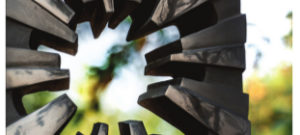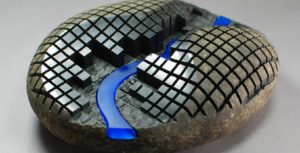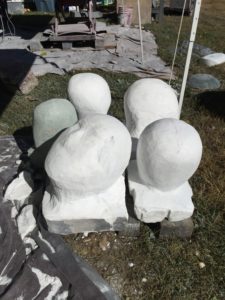
Home » Journal Articles » Thoughts & Opinions » Eight easy steps to polishing basalt
Many carvers are intimidated by the difficulty of sanding and polishing basalt. This is entirely unnecessary. Basalt is in fact very easy to finish if you follow these eight easy steps. Soon you will discover that deep space raven’s wing glow within your own dark and crusty igneous chunks.
1. Prepare the work site environment. A comfortable work environment is essential to polishing basalt. Take your tools and stone to your favorite sandy beach where the temperature holds at a steady seventy degrees. Plane tickets may be necessary. If customs officials ask what that dense dark lump is just tell them it is depleted uranium 238, they seem to be comfortable with that. (Do not ever tell a customs official that you are an artist). Burn sage or incense and ask a local shaman or priestess to do a purification ritual for you.
2. Play music. Music is helpful in polishing basalt; not only does it distract you from the tedium of your inner dialogue (“damn scratch, damn scratch. Gwyneth is pregnant? Damn. This piece has to be delivered tomorrow etc. etc…), but it has also been clearly shown that specific sound wave patterns are able to ‘loosen’ the molecular structure of basalt. Are the large crystalline fracture patterns born of the cries of pterodactyls flying overhead?
3. Develop patience. Polishing basalt is like raising a teenager; they respond unpredictably from day to day and require long term persistence and love. If you do not have a teenager, get one or borrow one. Many will be enthusiastic about visiting you if tell them you will let them polish the basalt.
4. Achieve non-attachment. Getting a good polish on basalt is like attaining enlightenment. Both require a ‘letting go’ or non-attachment to the goal. Many of my basalt polishing friends are accomplished meditators and have found that basalt polishing is relatively effortless once they have attained enlightenment.
5. Develop good hand-eye coordination. Many experienced basalt polishers were once involved in slightly less challenging careers like neurosurgery or classical violinist or pianist. Consider taking up hobbies like these to prepare your hands and eyes for basalt carving.
6. Maintain flexibility and strength. There are many yogic poses that are useful for the basalt polisher. The Twisted Crane is particularly useful for strengthening and stretching of lower back muscles. Yogic historians believe this pose was developed by the stone carvers of the Mahabaliparam temples in 7th century India. It is interesting to note that a very similar pose can be found in the Egyptian fresco at the tomb of Nakht in Thebes (c.1450 B.C.). In these images the carvers are shown holding tapered conical blocks that look suspiciously like silicon carbide cup wheels.
7. Experiment. Imagine that you are a witch or wizard on the cutting edge of an alchemical discovery. There are many esoteric pastes and powders that have been used over time to assist in polishing and buffing basalt. These recipes tend to be personal, but I will list for you some of the ingredients that are better known: blood (source?), beer, sweat, chocolate, tears, Turkish coffee, garlic paste, bodily fluids (take your pick), the excrement of the Mayan Quirigua bird, eyeball of Newt, dragon scales, etc. Try your experiments on test pieces first.
8. Finally. Don’t be afraid to ask for help. There are probably many experienced basalt polishers in your neighborhood that would be happy to help you. They tend to be shy, though. If you slowly drive around your neighborhood in your flatbed with a three- or four-ton chunk of pristine columnar basalt in back, the basalt carvers will come to you. If anyone comes up to you and asks, “Is that a rock?” they are probably not a skilled basalt polisher.
As you can see, it is really quite simple to polish basalt. A little preparation goes a long way. In the next issue I may share with you a simple design I have used for making my own water jet cutting system out of vacuum cleaner parts, duct tape and military surplus artillery components.
Thank you,
Tomas Littlehammer




We need some kind of descriptive text here.